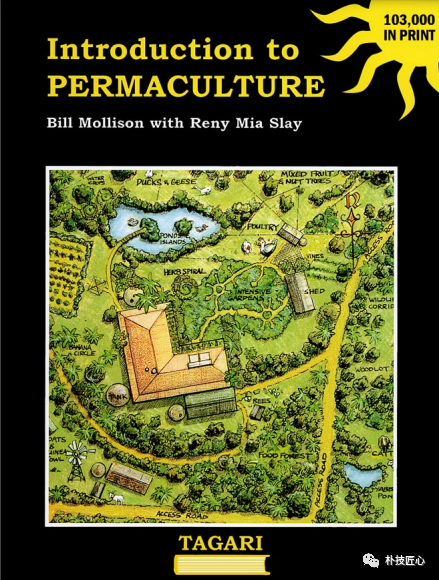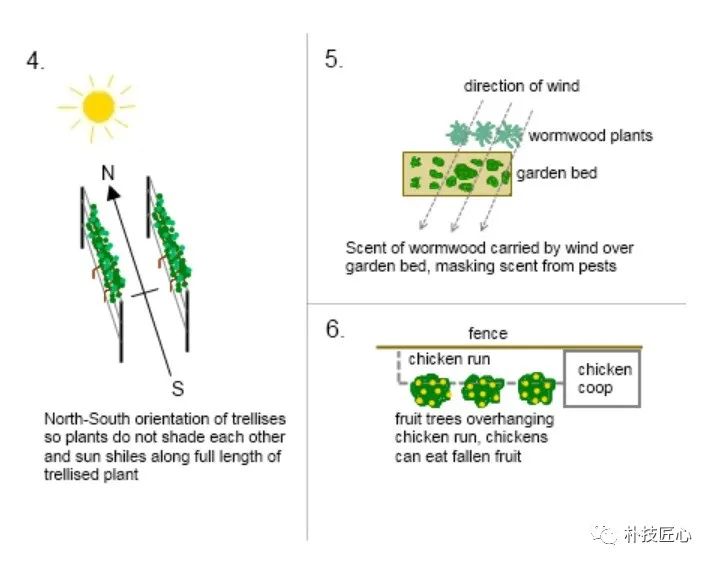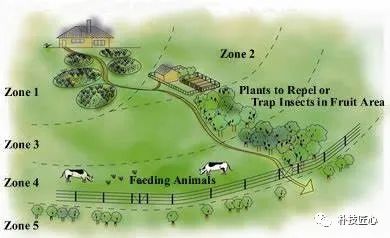置顶星标 我们就不会走散了

永续农业理念
关心地球
关爱人类
合理分配节余的时间、金钱和物质
以实现前面两项
-永续 设计-
There are two basic steps to good permaculture:e sign. The first deals with laws and principles::at can be adapted to any clirnatic and cultural:ondition, while the second is more closely'ssociated with practical techniques, which:hange from one climate and culture to another.
优秀的永续农业设计有两个基本步骤:
第一个步骤是,适应于任何气候条件和文化背景的规则和原则;
第二个步骤是,在不同的气候和文化改变中,要与实用技术联系在一起。
The principles discussed in the followingrages are inherent in any permaculture design,in any climate and at any scale. They are seiected from principles of various disciplines:ecology, energy conservation, landscape design, andenvironmental science, and are, briefly,as follows:
以下讨论的是所有永续农业中都固有的设计原理,适用任何气候和任何规模。
它们选自不同学科的原理:有生态学、节能、景观设计和环境科学,简而言之,有以下几点:
Relative location: every element (such ashouse, pond, road, etc.) is placed in relationshipro another so that they assist each other.
相对位置:每一个元素(如房屋、池塘、道路等)在配置时要考虑与另一个元素之间的关系,以便它们相互协助。
Each element performs many functions.
每个元素都发挥多种作用。
Each important function is supported bymany elements.
每个重要的功能都有多个元素支持
Efficient energy planning for house andsettlement (zones and sectors).
为房屋和住区做高效节能规划。
Emphasis on the use of biological resourcesover fossil fuel resources.
要优先使用生物资源而不是化石燃料资源。
Energy recycling on site (both fuel andhuman energy).
现场能源循环利用(包括燃料和人力)。
Using and accelerating natural plant succession to establish favourable sites and soils.
利用和加速植物自然演替,建立有利的场地和土壤。
Polyculture and diversity of beneficialspecies for a productive, interactive system.
利用有益物种的混作和多样性栽培,建立一个更有成效的互动系统。
Use of edge and natural patterns for besteffect.
使用边缘效应和自然模式以达到最佳效果。
Relative Location相对位置
The core of permaculture is design. Design is aconnection between things. It's not water, or achicken, or the tree. It is how the water, thechicken and the tree are connected. It's the veryopposite of what we aÍe taught in school. Education takes everything and pulls it apart andmakes no connections at all. Permaculture makesthe connection, because as soon as you've gotthe connection you can feed the chicken fromthe tree. To enable a design component (pond,house, woodlot, garden, windbreak, etc.) tofunction efficiently,we must put it in the right place.
永续农业的核心是设计。所设计的是事物之间的联系。
它不是水,也不是鸡,更不是树。
而是水、鸡和树是如何联系的。
这与我们在学校里,所学到的东西是完全相反的。
教育把所有的事物都分开,完全切断它们之间的联系。
永续农业是建立联系,因为一旦有了联系,你就可以用树来喂养鸡。
为了使设计元素(如池塘、房屋、林地、花园、防风林等)高效地发挥作用,我们必须把它们放在正确的地方。


For example, dams and water tanks are located above the house and garden so that gravityrather than a pump is used to direct flow. Homewindbreaks are placed so that they deflect windbut do not shade the house from the winter sun.The garden is placed between the house and thechicken pen, so that garden refuse is collectedon the way to the pen and chicken manure iseasily shovelled over to the garden, and so on.
例如,将水坝和储水箱安置在比房屋和花园跟高的地方,以便利用重力而不是泵来引导水流。
房屋防风林的位置,能够挡住风,但冬天不会遮挡房屋的阳光。
花园放在房子和鸡圈之间,这样花园的垃圾就可以在去鸡圈的路上收集起来喂鸡,鸡粪也可以很容易被铲到花园里,等等。

We set up working relationships betu'eeneach element. so that the needs of one elementare filled by the yields of another element. To dothis, we must discover the basic characteristicsof any element, its needs, and its products (seeBox).
我们在每个元素之间建立工作关系,使一个元素的需求由另一个元素的产量来满足。
要做到这一点,我们必须找到各个元素的基本特征,需求和它的产品。
The elements in a typical small farm mightinclude: house, greenhouse, garden, chickenpens, water storage tank, compost pile, beehives, nursery area and potting shed, woodlot,dam, aquaculture pond, windbreak, barn, toolshed, woodpile, guest-house, pasture, hedgerou',worrn beds, and so on. These can be movedabout, on paper, until they are working to bestadvantage.
一个典型小农场的元素可能包括:房屋、温室、花园、鸡舍、储水箱、堆肥、蜂箱、育苗区和盆景棚、林地、水坝、水产养殖池、防风林、谷仓、工具棚、木柴堆、客房、牧场、树篱、蚯蚓床等。把这些元素在设计稿上相互移动,直到找出它们发挥出最佳配置方案。
In the case of every element, we can base ourlinking strategies to these questions:
就每一个元素而言,我们可以根据这些问题来制定配置策略:
"Of what use are the products of this particular element to the needs of other elements?"
"这个特定元素的产品对其他元素的需求有什么用?"
"What needs of this element are supplied b1'other elements?"
"这个元素的需求是由其他哪些元素来提供?"
"Where is this element incor.rpatible u'ithother elements?"
"这个元素与其他元素在哪里不相容?"
"Where does this element benefit other partsof the system?"
“这个元素对系统种的其他部分有何益处?”
It is best to start with the most important nodeof activity (e.g. the house, or even a commercialcentre such as nursery, free-range chicken farm,aquaculture, etc.).
最好从最重要的活动节点开始(例如房屋,甚至是商业生产,如苗圃、自由放养的养鸡场、水产养殖等)。
For things to work properly,we must remember that:
为了使事情正常进行,我们必须记住:
The inputs needed by one element aresupplied by other elements in the system; and
一个元素所需的输入是由系统中的其他元素提供的
The outputs needed by one element are usedby other elements (including ourselves).
一个元素的产出能满足其他元素(包括我们自己)的需求。
文章翻译英文版《永续农业概论》电子书
需要的对话款回复:永续农业概论 下载
(付费资源)

